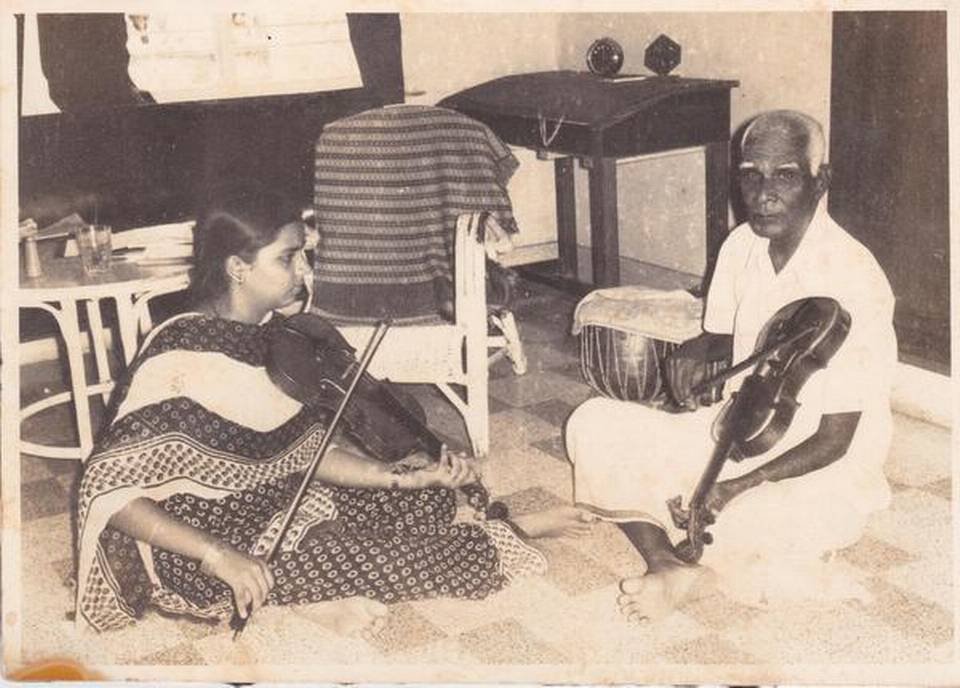Kala Ramnath pushes boundaries with the Singing Violin!
-Lakshmi Anand, The Hindu.
AUGUST 27, 2020 16:58 IST
Kala Ramnath pushes boundaries with the singing violin - The Hindu
Hindustani violin exponent Kala Ramnath was recently inducted by the New York Press into the list of 100 Most Influential Asians.
Behind Kala Ramnath’s simple and unassuming persona is a musician who has put her distinctive stamp on the Hindustani violin. One of the youngest recipients of the Sangeet Natak Akademi Puraskar, she has been hailed as one of the world’s 50 best violinists, was the first Indian to be featured in the violin Bible The Strad, and her album ‘Kala’ was selected as one of the UK-based Songlines magazine’s 50 best recordings. The New York Press recently inducted her into the list of 100 Most Influential Asians. Despite being globally recognised, she is little known in South India, despite having been raised in Chennai.
To begin with, the violin is uncommon in Hindustani music. Kala, however, has blazed a trail all her own, after V.G. Jog and her paternal aunt, N. Rajam, got it recognition. Kala reinvented the handling of the instrument, producing a uniquely refined sound that is much lauded by critics the world over. She developed the technique to convey minute microtonal nuances as clearly as the human voice — earning her instrument the epithet of ‘the singing violin’.
The articulate Kala, who speaks with conviction, says that musicians should not offer their art for free, pandemic notwithstanding. “If you want to be seen online, then teach, offer advice, help others,” she says. “Performing at home, without accompanists, cannot be called a concert. That is merely personal practice. If you want to post a concert, then do a professional recording with accompanists and charge for it.”
Tough training regimen
Kala’s training began in 1969, at age two, under her grandfather, A. Narayana Iyer. “Thatha would ask me to practise exercises a hundred times. If I faltered, even at the 99th time, I had to start all over again.” At the successful completion of each sequence, she could choose one colour of candied fennel seeds. Apart from the time spent in school and on homework, every moment was devoted to practice. “I have never gone on excursions, had friends over, or visited them. No Enid Blytons or Perry Masons. I got one day off a year – Saraswati Puja.”
Young Kala with grandfather A. Narayana Iyer
She attended Hindustani concerts in Chennai, playing before many artistes including V.G. Jog at age seven. She played for Pt. Bhimsen Joshi in 1980, the year her uncle, T.N. Krishnan, received the Sangita Kalanidhi. Her first public performance was at age 12 in Bombay, a duet with Rajam’s daughter, Sangeeta, arranged by Rajam and presented by Pt. Jasraj. Later, in 1982, Ustad Zakir Hussain asked why anyone would listen to an imitation of her aunt. “Another reason I eventually went to Pt. Jasraj,” she says.
She received the A Grade from All India Radio, one of the youngest to get it. And grew up unaware of her prowess, perhaps the keystone to her being so grounded even today. Relocating to Bombay, she became one of Pt. Jasraj’s prime disciples, mostly imbibing his art by accompanying him at concerts. Kala’s understanding of the placement of individual notes became intensely embedded. She gives an example. “Though both have the ‘komal re’, the ‘re’ of Bhairav is higher than the ‘re’ of Shree.” This awareness is so acute that she can sing or play at any sruti without tanpura for reference.
Modification process
“Jasraj-ji pioneered the importance of sahitya in Hindustani music,” she says, “even researching Haveli Sangeet to reflect the original lyrics.” Kala reworked every aspect of the instrument and its playing to reproduce the nuances of Pt. Jasraj’s singing. Knowing that the moving of fingers from string to string, and within various points on the same string takes time, she rethought it completely — optimising and minimising as needed. To round out the sound, she began using ¾ viola strings and started playing at a pitch of 2 for her solos.
On what it takes to be a successful performer, she mentions several aspects, of which the first is to remember one’s guru but not blindly copy him or her, as Zakir Hussain had pointed out. Pt. Jasraj made the point differently — one’s biological children might resemble one initially but soon their individuality will come through. So too should one’s music present its unique self with an undertone of its provenance. Secondly, riyaaz (practice) should not only be quantitative, but qualitative. Thirdly, it makes a real difference whether someone is in music because they want to be versus because they have to be in it. She stresses on realistic expectations. “This is a niche field. Classical musicians cannot expect the kind of adulation and following of pop idols.” Additionally, she emphasises the importance of honouring a commitment, remembering Pt. Jasraj’s tenacity wistfully. “Sickness or otherwise, one should not renege on what one has accepted, he would say.”
Kala just released a new album titled ‘Rang’, a collaboration with talented tabla artiste Bickram Ghosh, made during the pandemic, with each artiste recording individually. Kala approaches collaborative musical engagements seriously. “Just getting together and playing on the spot is a jam session, not a collaboration,” she explains. Her works with the Danish Symphony, jazz orchestras and the London Symphony Orchestra took many months of active engagement.
Kala Ramnath is now introspecting deeply into the music. “Looking at various raags, elaborating them differently, delving into challenging compositions, analysing one raag from the perspective of another allied raag: I am exploring these aspects minutely. Bringing out more beauty in the raag is what excites me now.”

